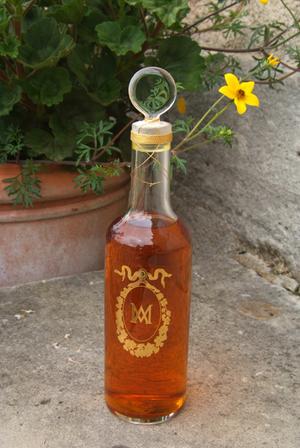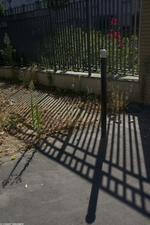Scented Thoughts: The Flacon of M.A. Sillage de La Reine by Le Château de Versailles

We love perfume flacons and in this sense we are the children of 20th century perfumery as defined by François Coty. This innovative entrepreneur and perfumer was a man of instinct and vision as he helped define the perfume concept as a mass-marketable object of luxury in which the container played an equal aesthetic role to that which was contained in it. He once said, "a perfume should attract the eye as much as the nose." The adequacy between the two signalled to Coty a successful fragrance, that is a fragrance capable of becoming the focus of women's aspirations and desires, their very expression in fact, until then perhaps only confusely felt and dreamt about. This message of Coty's is famous but not necessarily ingrained, even today 102 years later, in people's mentalities. Many a perfume wearer today will still consider the juice itself to be more significant than its container. This is a perfectly acceptable proposition but it does not explore fully what beauty and luxury can be as fuller, more complete experiences...
This is not to say that we should develop a snubbery for perfume forms. The message from Coty is very clear, his ideal perfume was a priori an oxymoron and a generous and cunning one at that: the luxury represented by a fragrance should not only be implied in its price but be refracted towards the consumer in the shape of a beautiful bottle to behold. Creating pleasure and even happiness both for the eye and the nose of the wearer will further encourage the consumer to seek out the reiteration of this experience.
Within this perspective, the perceived balance between the visual and olfactory aspects of a perfume is key otherwise the flacon becomes a mask for wretched quality, a ruse to trick the consumer into imagining the perfume to be attractive and beautiful when it is not so to the nose. It suffices to have had a few disappointing experiences and one may then choose to retreat into purism, a position asserting that the part of the perfume that truly matters is that which is contained, the juice.
I am writing this text very quickly and so these thoughts are subject to change. These thoughts are immediately provoked by the sight of the Baccarat bottle for the recreated perfume of Marie-Antoinette, M.A. Sillage de la Reine. It is indeed a bottle more than a flacon. I am struck by its rustic quality, perhaps a reference to Marie-Antoinette's taste for the bucolic. In fact, I initially thought it to be the less expensive edition of the perfume, the one priced at 350 Euros. It is actually the Baccarat edition priced at 8000 Euros. The proceeds are meant to be applied towards the restoration of the quarters at Versailles formerly inhabited by the French queen, so we may be reminded in this way that this is about economics rather than luxury perfumery, but still. Apart from Marie-Antoinette's monogram in gold, the rest of the perfume bottle is disarmingly simple. The stopper betrays a modern quality, I think.
It leaves me to wonder why the Château de Versaille chose this model, perhaps for historical reasons? Perhaps it is the faithful replica of a bottle used by Jean-Louis Fargeon or one from the travel case of Marie-Antoinette. It looks very much like an apothecary's flacon or a bottle of wine or cologne. Perhaps, if I had to guess, it is the expression not of luxury but of aristocracy. It embodies its simplicity and affinities with peasantry and the rural world.
Would Coty have deemed this bottle worthy of a great jus? I tend to think not. He called upon Lalique and Baccarat to help him define a new direction in luxury perfumery, conceiving of the perfume bottle as a shrine, and these collaborations produced masterpieces. As a child of this powerful 20th century trend I am left to wonder before the discrepancy between the plainess and simplicity of the bottle and its price. I think I can safely say that, at least, it does not scream "nouveau riche".
Sources: Run Around Paris and Le Château de Versailles. Photo is by Christian Milet.
You can check my previous posts about Sillage de la Reine:
More Comprehensive Details about Sillage de la Reine.
A Party for Sillage de la Reine.
Book Review of A Scented Palace.









Belle Helene-
Mon Dieu! Ca coute bien trop cher, trop riche pour mon sang, je t'assure...
Ca doit etre un vrai chef d'oeuvre, j'espere, mais, tant pis! Je n'aurais jamais avoir l'occasion de l'essayer!
Salut...
I'm curious as to how much juice one gets for the 8,000 Euro bottle?!
Oh, it's beautiful! But the stoppered bottles always make me nervous -- what if it falls over and spills?!? I suppose if you can afford the first, you can afford another...
Bonjour Chaya,
Je suis tentée d'acheter la bouteille de Sillage à 350 Euros, mais je ne me suis pas encore décidée.
On verra.
Bonne journée!
Christina,
I know that for the Portieux edition the quantity is 25 ml. I would have to double-check for the Baccarat edition.
Helene,
I have a photo of the Portieux flacon, if you'd like me to forward it to you. It is quite elegant and not like the rustic Baccarat! Both will hold 25 mls.
March,
I am thinking actually that perhaps what one needs to do in order to be historically accurate is to get a fancier bottle and transfer the juice into it. Because, truly, this is not the best container in practical terms. I think I would have preferred an earthenware bottle if they wanted to keep it simple.
Anya,
I would love to. Thank you for the information. I'll see if I can get more info about the model for the Baccarat edition and perhaps the Portieux's too once I get a chance to compare both.